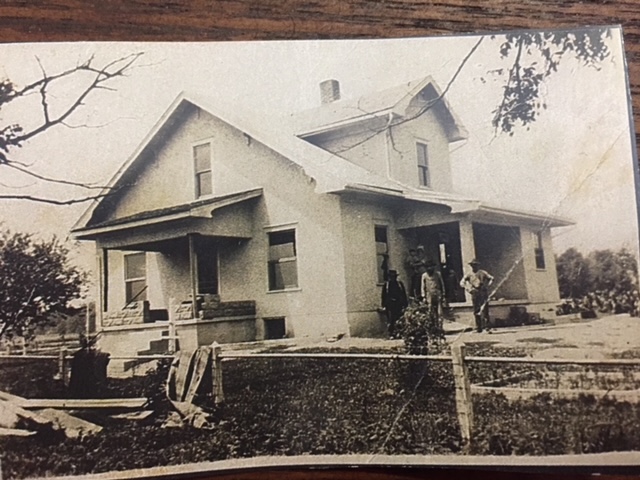
Family homestead built by the Condon’s around early 1900’s as original home burnt.
The story of the Michael’s, Brumbaugh’s, Sease and Stewart farm families written by Annette Sease Stewart.
EVERY FAMILY HAS A STORY….WELCOME TO OURS My Great-Grandpa and Grandma, George and Emma Michael, bought our homestead on Karr Road in 1928. George was the son of Joseph Michael and Barbara Sirch. He was a farmer and Emma was the daughter of Martin Hofacker and Leah Fourman. Grandma and Grandpa Brumbaugh, Inez and Delbert, and my mom, Betty, lived here from 1928 until my mother, Betty, married in 1944. Grandma and Grandpa then moved to Arcanum in 1950, living on East George. Grandpa worked for Blevins Popcorn Factory and they cleaned and attended the Faith United Methodist Church. Delbert was a farmer, also. Then, our family moved here in 1950. This would be Dale, Betty, Fred, Shanda. I was born a few years later. My mom and dad moved to Arcanum on North Main in 1978 and we moved onto the farm in the summer of 1978. (Ken Sebring, Annette, and Rachel.) Young Kenneth was born a few years later and Kenneth the father was killed in an accident in 1980 the same year. Annette then married Rex Stewart and along with our two children, we have farmed this farm and do so presently.
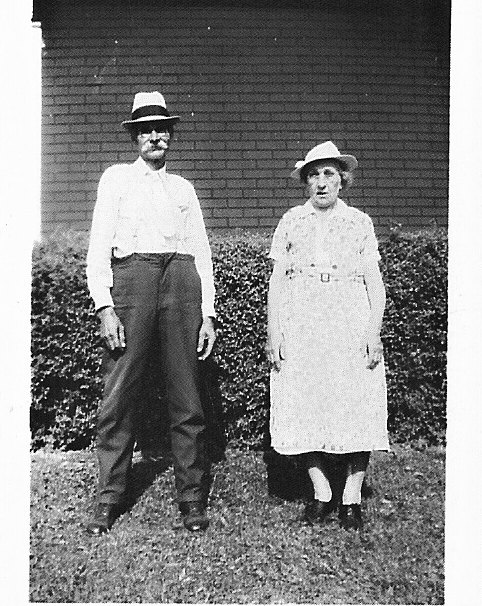
George & Emma Michael, my great grandparents
The farm has been actually farmed by the family from Grandpa Delbert down to our family of Rex, Annette, Rachel, and Kenneth. It has been a working farm raising grains and at one time beef cattle and hogs. Plus, lots of kittens and at least eight dogs. Tobacco was earlier estimating from 1930-1960’s. When Grandma and Grandpa Brumbaugh lived here, the farms were small and most farmers, including my grandparents, raised dairy cows, chickens, and hogs. Grains were raised to feed the livestock such as hay and wheat as well as corn. There may have been some oats to mix in the livestock feed rations. They also had work horses to plow and work the ground. Hay, oats and corn were part of their diet. Later in the 1940’s my grandpa had a John Deere tractor. As today, farming crops, practices, and machinery has changed to keep pace with the farming business.
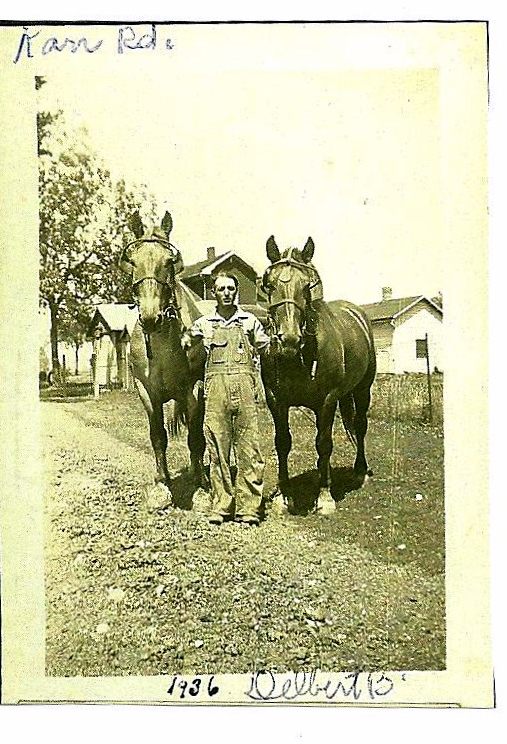
Delbert Brumbaugh, my grandpa.
From my mother’s story, we learn that the dairy cattle supplied us with rich milk and cream which we kept the cream for cooking and butter. Extra eggs were sold in town to build the wife’s nest egg or spending money. Hogs were an important commodity because they provided several different types of products including pork sausage, smoked hams and bacon, cracklings and from the lard used for frying, lye soap was made. They made their own stuffed sausage from the hog’s inwards. Beef cattle and soybeans weren’t around until later.
The gardens were a huge part of the farm as it was a sizeable truck garden as well as orchards for fruit. Items were canned and preserved. There wasn’t electric until the 1930’s or refrigeration so cooking methods and storage means were vastly different. The old wood stove sat in the kitchen and water was heated for dishes, laundry and baths.
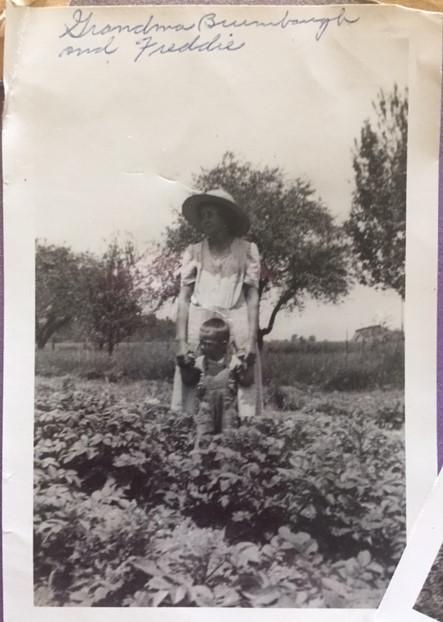
Inez Brumbaugh and Fred Sease, my grandma and brother out in the truck garden and orchard.
If you were fortunate, a separate building known as a “wash house” was used to heat the vast amounts of water for laundry and a gasoline powered washing machine was used over the wash tub. Laundry was dried outside and in the basement during rainy or winter weather although a few times laundry was put outside to “freeze” it white.
When my parents farmed and lived here, soybeans were introduced and with that the tobacco farming for us came to a stop. We also didn’t raise chickens or dairy cows but instead raised cattle for beef and hogs which we farrowed sows for baby pigs which were raised to market hogs. When Rex and I married, a few years later, we were farrowing sows in the late 1980’s and operated a ¾ acre of strawberries for a U-Pick operation. We continued to raise soybeans, corn and wheat and discontinued the wheat when no till become more popular and straw wasn’t needed for the hogs anymore
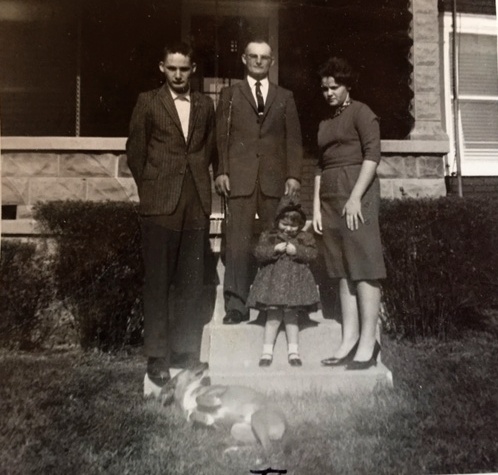
Dale, Fred, Shanda and Annette Sease at farm
There have been a lot of changes from tearing down buildings and fences to putting up some new buildings to adapt to larger farm equipment and a grain system The original house was white stucco and then red shingles were put on with a green roof and white trim. It contained two porches and dark stained pine woodwork. There was a pump room, parlor, open stairway, kitchen, downstairs guest bedroom, and dining room plus a cellar. Upstairs was three bedrooms where my mom and her parents slept. The stairway was open at the top and my mom, Betty Brumbaugh Sease, had her playroom there. In later years, this was enclosed for a storage room. Outside buildings included: a wash house for doing laundry and included a smoke house in the back, one car garage, tobacco barn, strip shed, block building, corn crib, chicken coop, and large old barn. There was a large truck garden and orchard complete with out house. Indoor bathroom wasn’t installed until 1959 and electric updated until the 1970’s to run a clothes dryer. as well as my dad’s welder, in the shop. In 1980 white aluminum siding was applied and new windows. In 2001 we starting an addition and it is a tan siding house today.
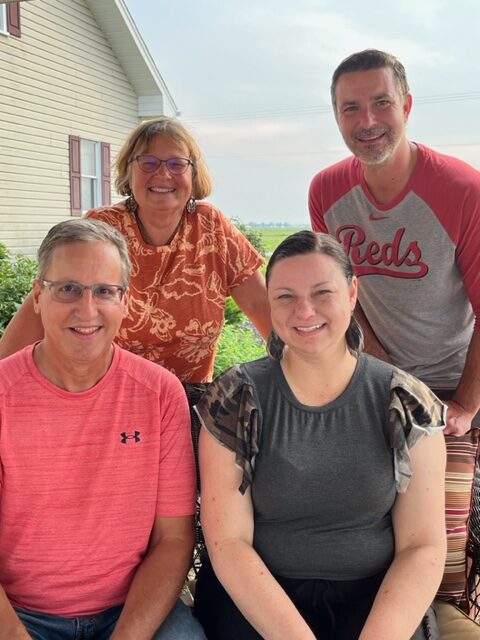
Rex, Annette Stewart and children Kenneth Stewart and Rachel Castle.
Times have changed also socially and domestically. As a kid living here, there was no clothes dryer until I was in Jr. High which was early 1970’s. No central air or air conditioners. Just fans and screens in the windows. My room was upstairs so yes it was freezing in winter and scorching hot in summer. Most older homes only had one bathroom, no dishwashers (except the kids) or laundry rooms. We played outside, took care of the animals, helped mow yard and weed the garden. And took bike rides all over the country side and to Pitsburg or Archers filling station on Rt. 49. Those were good times, though.
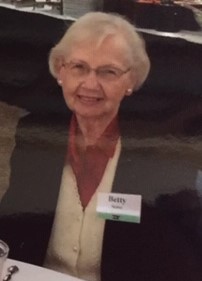
My Mom, Betty Sease
Our children tell stories and good times on the farm raising hogs for their 4-H projects for the fair and helping pick strawberries in their earlier years. As well as many buckets of green beans! Today, we gather for family dinners and the holidays, with the grandchildren coming and building their memories and traditions.
It is worthy to note that this farm was passed through the women’s lines. From George Michael to his wife, to Emma’s only daughter Inez, to her only daughter which is my mom Betty. Rex and I purchased the farm after my grandma passed away.
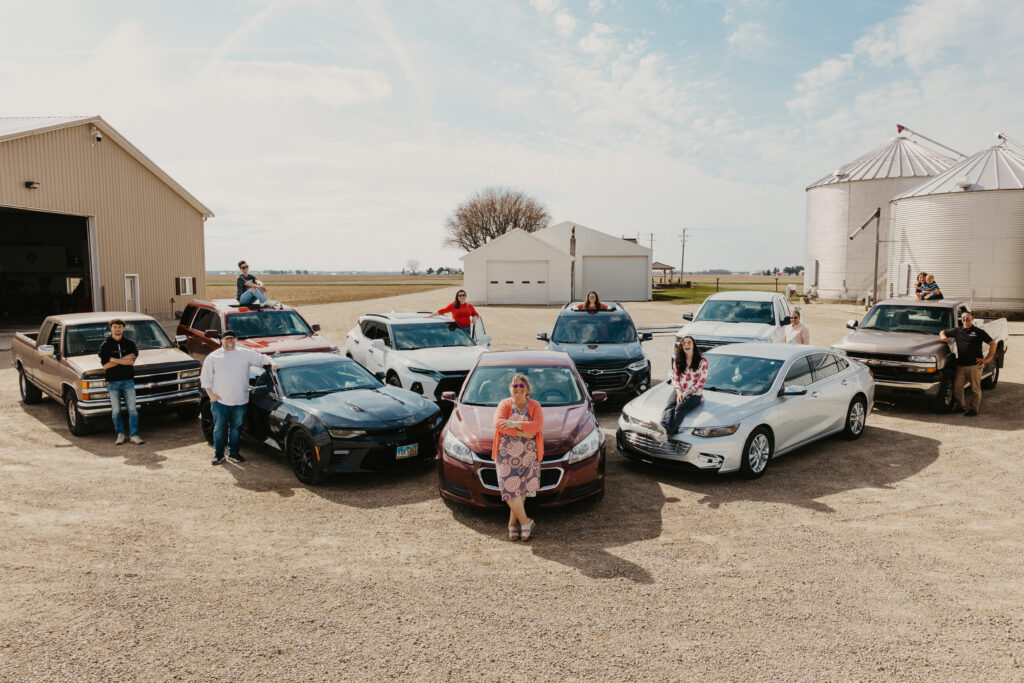
Our “Chevy” family
It has been a “family affair” as the women AND men have worked side by side through almost 100 years caring for the land, raising their families and tilling the soil to preserve a legacy to pass down to the next generations and doing what they love. We’ve walked hand in hand through joys, hardships, sorrows as well as good family times working hard to pass the love of our faith, family, and farming to those next in line as well as our community.
We are extremely grateful to the generations before who had the foresight ,as well as wisdom. along with high standards and a strong work ethic, to help each generation to be able to pass the legacy down. We thank our faith in Jesus, who has provided generously and faithfully and all honor and glory is His alone.
Thank you for reading my story. Blessings.
We welcome your farm stories and photos. It is a part of preservation-to record and pass your family’s legacy on to the next generation. Hopefully, the land as well as the story.
Please follow AWTHS blog guidelines. Content is property of AWTHS archives and story and photos are credit to Annette Stewart..
